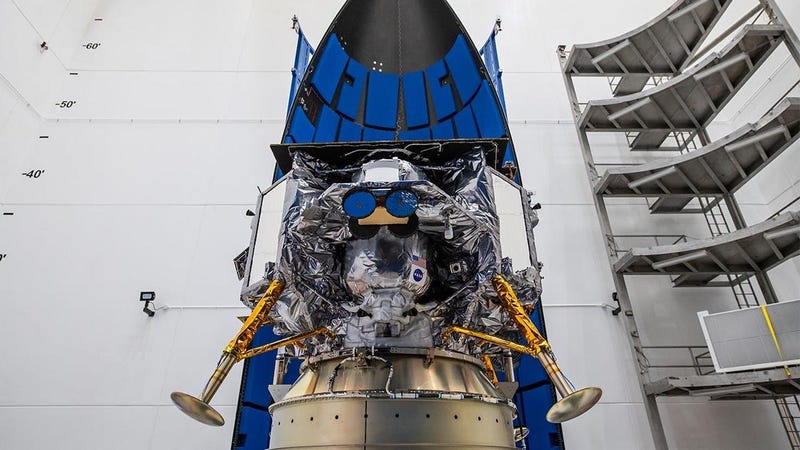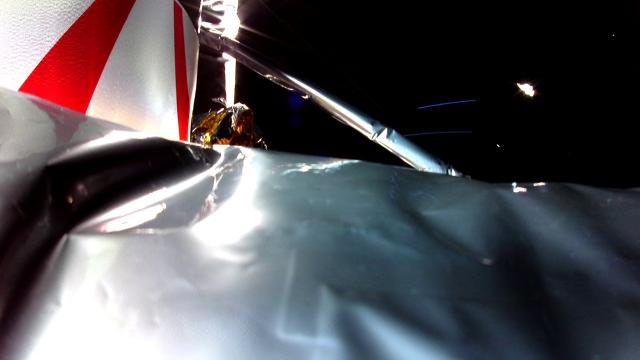A mission to land a private U.S. lander on the Moon, and the first U.S. lander since the Apollo era, looks to be ending before it even had a chance to get started.
The mission was ticking along nicely, until it wasn’t. Peregrine, perched atop United Launch Alliance’s Vulcan Centaur, blasted off to space from Cape Canaveral, Florida, during early Monday morning. Almost immediately, the spacecraft forged a link with NASA’s Deep Space Network. The company’s proprietary avionics system operated as expected, with Peregrine’s thermal, propulsion, and power controllers switching on. Around 10:00 a.m. ET, Astrobotic declared the probe as having entered into a “fully operational state.”
In the same update, however, the Pittsburgh-based company noted that an anomaly had occurred that was preventing Peregrine from “achieving a sun-pointing orientation,” inhibiting the probe from collecting solar power for its battery. In a noon update, Astrobotic pinpointed the cause of the anomaly as coming from Peregrine’s propulsion system, grimly noting that, “if proven true,” the glitch would threaten the “ability of the spacecraft to soft land on the Moon.”
With the spacecraft battery approaching critically low levels, and just prior to Peregrine entering into a planned communications outage, Astrobotic performed a maneuver to point the solar panels toward the Sun. With communications reestablished a short time later, the company confirmed that the maneuver worked, that Peregrine’s solar array was pointing toward the Sun, and that the battery was in the process of being charged.

But a fourth update, posted on X just after 2:00 p.m. ET, was less optimistic, revealing the seriousness of the situation. “Unfortunately, it appears the failure within the propulsion system is causing a critical loss of propellant,” Astrobotic noted on X. “The team is working to try and stabilize this loss, but given the situation, we have prioritized maximizing the science and data we can capture.” To which it added: “We are currently assessing what alternative mission profiles may be feasible at this time.”
Oof. The phrases “critical loss of propellant” and “alternative mission profiles” do not bode well. It’s fair to conclude from these updates that the 2,829-pound (1,283-kilogram) Peregrine lander will not touch down on the Moon in late February, in what was supposed to be the United States’ first lunar landing since the Apollo era. The plan was for the lander to touch down at the Gruithuisen Domes, a cluster of volcanic formations in the Sinus Viscositatis region. The likely mission failure will serve as a big blow to Astrobotic, which developed the lander under NASA’s Commercial Lunar Payload Services program. In 2019, Astrobotic was awarded a $US79.5 million contract for Peregrine Mission One (PM1), but additional costs stemming from the covid-19 pandemic and resulting supply chain issues raised the price tag to $US108 million.
Related article: Swarming Robots, DNA, and Bitcoin: The Wild List of Stuff Heading to the Moon Next Week
In addition to five NASA payloads, Peregrine is carrying an assortment of goodies meant for the lunar surface—including swarming robots, a student-built rover, radiation detectors, a piece of Mount Everest, a physical bitcoin, and time capsules.
What’s more, the probe is carrying the cremated remains of over 200 individuals, in addition to DNA (in the form of hair) belonging to former U.S. presidents, legendary science fiction author and futurist Arthur C. Clarke, and cast members of the original Star Trek television series (including Nichelle Nichols, who portrayed Lieutenant Nyota Uhura). Celestis planned to deposit the cremains on the lunar surface and send their DNA on a journey to deep space, aiming for it to enter a solar orbit beyond Mars. Elysium Space was also responsible for sending cremated remains, which were intended to be delivered to the lunar surface.
We’re still awaiting official word on the status of Peregrine-1 and how Astrobotic intends to salvage the mission, but NASA’s CLPS initiative is off to a difficult start. The purpose of these collaborations is to enhance NASA’s ability to explore the Moon, and with a focus on affordability and sustainability. NASA’s strategy of increasingly relying on private sector partnerships for its operations is now likely to face heightened scrutiny. The (apparent) mission failure will also be of big concern to Houston-based Intuitive Machines, which is likewise working under CLPS contracts; the company plans to launch multiple lunar missions this year.
Peregrine likely won’t make it to the Moon, and in recent years, lunar landings have faced significant challenges. In 2019, Israel’s Beresheet and India’s Chandrayaan-2 lander crashed, and in 2023, Russia’s Luna-25 and Japan’s ispace Hakuto-R M1 also crashed, underscoring the technical difficulties and risks associated with autonomous landings on the Moon’s challenging surface.
If there’s a silver lining in any of this, it’s that ULA’s Vulcan Centaur performed nominally during its inaugural flight. In development since 2014, the 202-foot-tall (61.6-meter) heavy-lift rocket is set to replace the company’s Atlas V and Delta IV rockets, providing launch services for both the public and private sectors.
